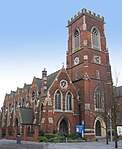Bedford Park is a suburban development in Chiswick, London, begun in 1875 under the direction of Jonathan Carr, with many large houses in British Queen Anne Revival style by Norman Shaw and other leading Victorian era architects including Edward William Godwin, Edward John May, Henry Wilson, and Maurice Bingham Adams. Its architecture is characterised by red brick with an eclectic mixture of features, such as tile-hung walls, gables in varying shapes, balconies, bay windows, terracotta and rubbed brick decorations, pediments, elaborate chimneys, and balustrades painted white.
The estate's main roads converge on its public buildings, namely its church, St Michael and All Angels; its club, now the London Buddhist Vihara; its inn, The Tabard, and next door its shop, the Bedford Park Stores; and its Chiswick School of Art, now replaced by the Arts Educational Schools.
Bedford Park has been described as the world's first garden suburb, creating a model of apparent informality emulated around the world. It became extremely fashionable in the 1880s, attracting artists including the poet and dramatist W. B. Yeats, the actor William Terriss, the actress Florence Farr, the playwright Arthur Wing Pinero and the painter Camille Pissarro to live on the estate. It appeared in the works of G. K. Chesterton and John Buchan, and was gently mocked in the St James's Gazette.
The development is protected by a conservation area in the London Borough of Ealing, and a smaller one in the London Borough of Hounslow. Over 350 of its buildings are Grade II listed; the church and the inn are Grade II*. The historian of London Stephen Inwood calls it probably the best garden suburb in London.








